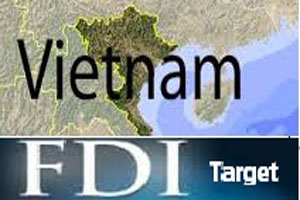
Vietnam fails to reach its FDI targets over policy shortcomings
YarnsandFibers News Bureau 2014-08-03 17:00:00 – VietnamInvestors continue to pour money into labor-intensive manufacturing (particularly garment and footwear and automobile factories) which mostly rely on imported materials and equipment. According to the HCMC Export Processing and Industrial Zones Authority (HEPZA), foreign investors announced plans to inject US$264.7 million into the zones in the first half of this year. Of the registered capital, nearly 80 percent will go into the textile and garment sector.
Offering foreign investors low taxes and land-use fees has only allowed foreign companies to exploit cheap resources, while doing little to help Vietnam increase its technological capacity. When Vietnam no longer offers those benefits, they may leave the country for other markets.
According to Japanese Economist Kenichi Ohno, multinational companies often invest in developing countries to cheaply execute the labor-intensive assembly stage without transferring the technology to local businesses. Only 5-6 percent of foreign-invested projects in Vietnam can be described as high-tech.
A lack of technology transfers might not be a good thing, but the situation could actually get worse if Vietnam becomes a dumping ground for outdated technologies.
Many foreign investors focus on exploiting cheap natural resources at low prices, and use outdated technologies that hurt the environment. In fact, fourteen percent of foreign businesses use outdated technologies--double the percentage of firms that employ high-tech methods and equipment.
The contributions made by foreign businesses aren't worth the damages to the country's resources and environment.
The FDI sector remains the most lucrative export generator in the country. FDI-backed manufacturers generated of $43.7 billion- (or 61.49 percent of the country’s total export revenues) in the first half of this year. However, the sector imported materials and equipment worth nearly $40 billion during that same period.
Many view the FDI sector's contribution to the country's overall growth as insignificant because the exports carried little to no added-value, according to the General Statistic Office.
According to Le Xuan Nghia, head of the Business Development Institute, the failure of Vietnam to reach its FDI targets was caused by policy shortcomings.
The government has offered overly-generous incentives to foreign investors, but hasn't required them to make any commitments about job creation or adding value to the local supply chain.
According to the UNIDO survey, there doesn't seem to be much difference in the performance of foreign firms receiving incentives and those not receiving incentives. Overall, foreign companies are less likely to invest in the future compared to domestic companies, as they expect more incentives, said Brian Portelli from the UNIDO.
Economist Pham Chi Lan said that many countries have begun offering privileges only to foreign firms willing to invest in sectors and localities that benefit the government's development plans. This aims to ensure that incentives will do actually trigger the desired investment outcome in terms of productivity performance and value added generation.
Vietnam should use incentives to direct cash toward specific projects and make sure it has the human resources to meet the needs of foreign investors. They should review which sectors need foreign investors and which could function with local firms operating with appropriate incentives.
Vietnam’s economy cannot rely on foreign investors who only come to Vietanm seeking profits that ultimately leave the country.
Brian Portelli said that the granting of investment incentives must become more selective since it's a very expensive strategy. A reckless distribution of incentives could undermine the national tax system and reduce state budget collection.
According to the Foreign Investment Department’s recent report, in the first seven months Vietnam licensed 889 new projects with a total investment of $6.85 billion, down by 0.9 percent compared with the same period last year. While, FDI disbursement during January-July period reached $6.8 billion, up 2.3 percent from a year ago.
Market Intelligence
Ask for free sample Report

experience
Customer Base
dedicated team
Countries Served Worldwide









